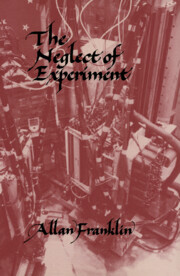Book contents
- Frontmatter
- Contents
- Acknowledgments
- List of abbreviations
- Introduction
- 1 The discovery of parity nonconservation
- 2 The nondiscovery of parity nonconservation
- 3 CP or not CP
- 4 The role of experiment
- 5 Do experiments tell us about the world?
- 6 The epistemology of experiment
- 7 The epistemology of experiment: case studies
- 8 Forging, cooking, trimming, and riding on the bandwagon: fraud in science
- Conclusion
- Notes
- Index
1 - The discovery of parity nonconservation
Published online by Cambridge University Press: 15 December 2009
- Frontmatter
- Contents
- Acknowledgments
- List of abbreviations
- Introduction
- 1 The discovery of parity nonconservation
- 2 The nondiscovery of parity nonconservation
- 3 CP or not CP
- 4 The role of experiment
- 5 Do experiments tell us about the world?
- 6 The epistemology of experiment
- 7 The epistemology of experiment: case studies
- 8 Forging, cooking, trimming, and riding on the bandwagon: fraud in science
- Conclusion
- Notes
- Index
Summary
In this chapter we shall examine the history of the 1957 discovery of parity nonconservation, or the violation of mirror symmetry in nature. The discovery began with the suggestion that parity was not conserved, a suggestion put forth as a means of solving a particularly vexing problem that had resisted all conventional attempts at solution. The revolutionary nature of this suggestion was clearly recognized by the authors, and that led them to suggest other experiments that would test the principle. Those experiments were then performed, with positive results, and that led to the overthrow of the principle of mirror symmetry. They were thus “crucial” experiments, in the sense that they unambiguously, and within a short period of time, decided the issue between two theories (or classes of theories) of some importance for a certain segment of the scientific community. We shall examine the evidence for this in Section 1.1.
What was not realized at that time was that there were already two experimental results in the literature, published in 1928 and 1930, that had the same physical and logical content and showed parity violating effects, but whose implications and significance were not recognized either by the authors or by any member of the physics community until after 1957.
It seems clear, then, that it is not only the physical and logical content of an experiment or series of experiments that determines its crucial nature; other conditions must also be present.
- Type
- Chapter
- Information
- The Neglect of Experiment , pp. 7 - 38Publisher: Cambridge University PressPrint publication year: 1986



